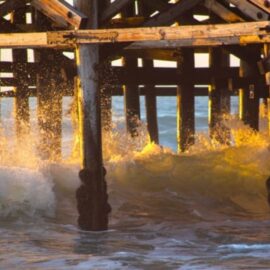

This article gives you a glimpse of what you can learn with Shortform. Shortform has the world’s best guides to 1000+ nonfiction books, plus other resources to help you accelerate your learning.
Want to learn faster and get smarter? Sign up for a free trial here .
What is the importance of environmental protection? What effects do climate change and warming temperatures have on the planet?
The natural environment is threatened every day. Humans are cutting down forest ecosystems, droughts are causing dangerous flooding, and high temperatures are lowering the GDP. This is all because humans are intervening with the environment, and it’ll only get worse if nothing is done to stop it.
Let’s look at the reasons why environmental protection is important for human lives, the economy, and the planet.
Why You Should Protect the Environment
From deforestation to climate change, disturbing the environment affects us all. Not only are human and animal lives at risk, but there’s also evidence that climate change affects the economy. This is why many scientists stress the importance of environmental protection—it affects almost every aspect of life.
Here’s why we need to reduce the negative human impact on the environment to protect it.
1. Environmental Protection Saves Human Lives
Around two hundred thousand years ago, in eastern Africa, a new species emerged. While not especially strong, fast, or prolific, the newcomers—Homo sapiens—proved to be uniquely inventive.
In The Sixth Extinction, journalist Elizbeth Kolbert argues that our species today is rapidly changing the shape of Earth and the composition of the atmosphere, in the process unleashing a mass extinction of most living things, quite possibly including ourselves.
When we rapidly multiplied and started demolishing forests to grow food and spreading animals, plants, and organisms to new continents, we changed the face of Earth. With the discovery of fossil fuels underground, we began our greatest transformation—of the makeup of the atmosphere and the oceans. Some plants and animals have survived by migrating. But many, possibly millions, are stranded where they are unable, or lack time, to adapt. Extinction rates are skyrocketing. No other species has so drastically changed life on Earth.
In what Kolbert calls the Sixth Extinction, what does the future hold for us?
One possibility, of course, is that through our transformation of Earth, we’ll destroy ourselves. We’re still dependent on Earth’s atmospheric and geochemical composition and its biological processes. By altering these systems—pumping carbon dioxide into the atmosphere, acidifying the oceans, cutting down forests—we’re threatening our own survival.
For a species, past longevity is no guarantee of future longevity. Ammonites lived for hundreds of millions of years before they disappeared. Regarding human prospects:
- Anthropologist Richard Leakey suggested, “Homo sapiens might not only be the agent of the sixth extinction but also risks being one of its victims.”
- Stanford University ecologist Paul Erlich described the future in even starker terms: “In pushing other species to extinction, humanity is busy sawing off the limb on which it perches.”
It’s also possible that human ingenuity will save us from our own foolishness. For instance, some scientists suggest we could restructure the atmosphere by dispersing sulfates to reflect sunlight into space. Or we could take up residence on other planets. In that regard, one author advises that “as long as we keep exploring, humanity is going to survive.”
However, in the scheme of geologic time, saving ourselves isn’t the most important thing. It’s that our actions will set the direction of life long after we and everything we’ve created are gone and another life has inherited Earth.
2. Preserving Trees Improves Air Quality
Another reason to consider the importance of environmental protection is because trees have more uses than growing food and providing homes for certain species. They’re also humans’ source of clean air. Trees clean and filter air by taking in the carbon dioxide we breathe out and creating oxygen for us to breathe in. But deforestation—whether it be just one tree or multiple trees—releases that stored carbon dioxide, which is a greenhouse gas.
As Bill Gates’s book How to Avoid a Climate Disaster points out, because of their molecular structure, greenhouse gases trap heat that would otherwise radiate out to space in Earth’s atmosphere. The higher the concentration of greenhouse gases in the atmosphere, the more heat is trapped and the warmer Earth becomes; hence the term “global warming.”
In Finding the Mother Tree, Suzanne Simard says we should think of the larger forest ecosystems as similar to human societies. Trees are complex, self-organizing, and adaptive. And, importantly, she says they are intelligent.
Simard points out that objectifying nature, and thinking of humans as separate from it (and even above it) is a modern Western construct and reflective of a colonialist mindset. First Nations tribes of the region had a symbiotic relationship with the land and existed entirely within these forest ecological communities, rather than viewing them from the outside. She ties all of this into the pressing issue of climate change.
Climate change, she argues, is occurring in large part because of human activities, and these activities are the product of a mindset that has moved away from viewing nature as living, sentient, and sacred, toward a mindset that can’t even imagine trees as sentient beings that have relationships. This, Simard argues, needs to change. Only when we recognize the forests as alive and intelligent will we have the wisdom to recognize that we must honor them because our lives and the quality of the air depend on them.
How We Can Save Trees
Some of Simard’s research shows that cultivated trees in clear-cut plots fared better in their earlier stages of life. But later they declined in health, while the trees planted with companions outpaced them. In the past, policies were put into place based on those earlier observations, without awareness of the shifts that can happen later in the trees’ life cycle.
Simard explains that because forest growth is a long and slow process, researchers can use statistical models to predict future outcomes based on current data. Those models show that forest growth declines with each successive clear-cut and re-planting and emphasize the importance of environmental protection. So one policy change she advocates for is a move toward a longer-term model for research that preserves the lives of trees. Just planting one acre of trees can produce more oxygen for people and other species to breathe and reduce carbon dioxide in the air.
3. Burning Fossil Fuels Affects Weather and Sea Levels
We’ve seen how climate change affects the state of humanity and how deforestation reduces the quality of the air, but what impact does it have on natural disasters and sea levels?
Similar to how deforestation contributes to climate change, burning fossil fuels for energy releases carbon dioxide into the atmosphere. The carbon atoms in fossil fuels would still end up in the atmosphere even without humans digging them up and burning them, but the process would take much longer.
All of the carbon atoms on Earth continuously cycle through four main reservoirs: the atmosphere, living plants and animals, rocks and sediment, and the ocean. While the carbon itself doesn’t change, it bonds to other atoms to form different molecules along the way; for example, carbon dioxide gas in the atmosphere, glucose in plants, calcium carbonate in shells, and limestone and shale in rocks. This circulation of carbon between the lithosphere (rocks), the biosphere (life), the ocean, and the atmosphere is called the carbon cycle.
Without human intervention, it would take millions of years for the carbon in rocks and fossil fuels to make its way back to the atmosphere via volcanic eruptions, and the amount of carbon stored in Earth’s crust and the atmosphere would remain relatively balanced. However, humans have accelerated the movement of carbon to the atmosphere by emitting the equivalent of a Mount St. Helens eruption every two and a half hours! (We add over 50 billion tons of carbon dioxide to the 130 to 380 million tons emitted by volcanoes annually.) Since we don’t pull that carbon dioxide back out of the atmosphere, we can think of our reliance on fossil fuels as unbalancing the carbon cycle, resulting in a warmer planet.
Our understanding of the impacts of global warming continues to evolve as scientists collect more data and as we experience them firsthand. Still, there’s no question that global warming affects ecological communities worldwide. We’ll introduce some of the well-documented impacts of global warming that Bill Gates highlights in How to Avoid a Climate Disaster, and why he thinks the importance of environmental protection is something worth considering.
Changing Weather Patterns
The warmer atmosphere partially caused by the burning of fossil fuels has caused long-term temperature and weather shifts, also known as climate change. For example, we now experience more frequent and intense heat waves, droughts, wildfires, and storms. By the year 2050, Gates cautions that billions of people will personally experience destruction from wildfires, drinking water shortages, or property damage from heavy storms and flooding.
The Rising Frequency of Extreme Weather Events
The relationship between climate change and extreme weather events is difficult for scientists to pinpoint because it’s impossible to know how extreme individual weather events would have been without climate change. However, scientists can gain insight into how climate change is shifting the frequency of extreme weather by comparing the likelihood of extreme weather events under baseline conditions (in other words, in a world without climate change) to their actual occurrence. For example, in the summer of 2021, the temperature in Portland, Oregon reached 116 degrees Fahrenheit. Researchers estimate that such extreme heat would only be expected 0.1% of the time in a normal year.
As temperatures continue to rise, we’ll likely see extreme temperatures much more frequently than probability would suggest—further evidence that climate change is creating a new threshold for extreme weather. For instance, between 2021 and 2022, 229 weather events caused over a billion dollars of damage each in the United States. In contrast, there were only 94 such natural disasters between 1980 and 2001.
Rising Sea Levels
The warmer atmosphere is causing sea levels to rise due to melting glaciers and ice caps (land-based ice that runs into the ocean as it melts) and thermal expansion in the ocean (water expands as it heats up). Gates notes that rising sea levels can be devastating for coastal communities because of storm surges, flooding, saltwater contamination of freshwater reservoirs, and loss of habitable land.
Already this year, California dealt with some of the worst consequences of warming temperatures. Typically, California has hot, dry summers that harden the soil and increase the chances of droughts and wildfires. Then, in the winter, the state has an increased chance of rainfall. However, the rising temperatures are causing even dryer summers and wetter winters.
In January, California experienced deadly floods and landslides that devastated communities. It happened because the hardened soil wasn’t able to absorb the unprecedented amount of rainfall. This is just one example of recent extreme weather events. It’s proof that environmental protection is more important now than ever.
4. Environmental Protection Saves Coral Reefs
Another consequence of releasing carbon in the air is the effect it has on the ocean—not just rising sea levels, but the ecosystems within the ocean.
Corals have endured for many geologic epochs, but researchers believe they won’t survive the Anthropocene—the current geological age defined by human activity. Instead, they’re on a course to be the first major ecological system to go extinct. According to The Sixth Extinction, the driving forces are acidification and climate change.
Some scientists project they’ll last out the century; others don’t give them even that long.
One paper in Nature predicted that visitors to the Great Barrier Reef in 2050 will find it rapidly disintegrating, which is why the importance of environmental protection can’t be ignored.
Coral reefs stretch around the middle of the globe. The largest is the Great Barrier Reef, which extends, with breaks, for more than fifteen hundred miles; in some places, it’s five hundred feet thick. The next largest is off the coast of Belize. There are also sizable reefs in the Pacific, the Indian Ocean, and the Red Sea, plus smaller reefs in the Caribbean.
Reefs are enchanting in their beauty—naturalist Charles Darwin described them as “amongst the wonderful objects of the world.” Biologically, they are even more distinctive. To take action to save coral reefs is to protect sealife and humanity. Coral reefs protect coastlines from storms and erosion and provide an ecosystem for life underwater. Additionally, coral reefs provide seafood and jobs in tourism, sport fishing, and marine recreation. Yet they are under dire threat.
Why Acidification Is Dangerous
Oceans, covering 70% of the earth’s surface, absorb a lot of the carbon we’re pumping into the air—two-and-a-half-billion tons a year when this book was written in 2014—which is changing ocean chemistry.
As a result, the pH of the oceans’ surface water has decreased, making them 30% more acidic than they were in 1800. The pH is on track to fall to 7.8 (from today’s average of 8.1) by the end of this century, making the oceans 150 percent more acidic than before the industrial revolution.
Ocean acidification may have played a major role in the most recent mass extinction event—the End Cretaceous. It’s believed to have been a factor in two more of the Big Five extinction events—the End Permian and End Triassic and possibly in two lesser extinction events.
5. Climate Change Causes Economic Damage
Finally, another reason why environmental protection is important is because climate change has a direct impact on our economy in areas such as housing and agriculture. As said before, warmer temperatures and rising sea levels cause flooding and extreme weather that damages properties and infrastructure, in addition to forestry and agriculture. These damages already cost the United States billions of dollars in just under a decade, decreasing the gross domestic product (GDP).
In False Alarm, Bjorn Lomborg says that gross domestic product (GDP) is the best proxy for prosperity. In short, GDP measures the total value of goods and services in a given society. Although GDP doesn’t measure every aspect of prosperity—like health, education, and life satisfaction—it’s highly correlated with those aspects. For example, higher GDP means there’s more money to invest in healthcare or schools. In general, increased GDP means more flourishing citizens.
Lomborg observes that GDP also affects climate change: As GDP rises, countries emit more carbon dioxide as they move from industries like agriculture to manufacturing, and as their citizens gain wealth they spend more on goods and services, which leads to more emissions. Conversely, many policies that reduce carbon emissions result in lower GDP, since countries have to switch from cheaper energy sources, like fossil fuels, to more expensive alternatives, like solar energy.
So, Lomborg concludes that when we assess climate policies, we must consider the effects of increasing temperature alongside the effects of increasing GDP. Ultimately, he concludes that on our current trajectory, climate change will cost about 4% of global GDP by 2100.
To reach this estimate, Lomborg cites Nobel Laureate William Nordhaus, who developed the Dynamic Integrated Climate-Economy model (DICE) that predicts the economic impact of climate change. DICE predicts the impact of climate change on many areas, like agriculture, energy, and biodiversity. By taking various parameters into account, like carbon dioxide emissions and human adaptation, it calculates the net economic impact of predicted climate change.
Using the middle-of-the-road scenario from MAGICC, which sees the temperature rise 7.4°F by 2100, DICE predicts that our GDP will be 2.9% lower than it would’ve been with no temperature rise. However, to allow for unexpected damages from climate change, Lomborg adds 25% to DICE’s predicted decrease in GDP, yielding a final estimate of a 3.6% drop in GDP. In other words, we can expect climate change to have a significant effect on global prosperity.
Lomborg uses this 3.6% reduction of GDP as his benchmark for evaluating climate policies. If a climate policy reduces GDP by less than 3.6%, environmental protection is worth considering.
Final Words
These five reasons showcase the importance of environmental protection—damaging the environment has a direct impact on us. If we don’t do something fast about these extreme conditions, then humanity will pay the consequences for its own actions against the environment.
Are there any more reasons why environmental protection is important? If so, let us know in the comments below!

Want to fast-track your learning? With Shortform, you’ll gain insights you won't find anywhere else .
Here's what you’ll get when you sign up for Shortform :
- Complicated ideas explained in simple and concise ways
- Smart analysis that connects what you’re reading to other key concepts
- Writing with zero fluff because we know how important your time is






